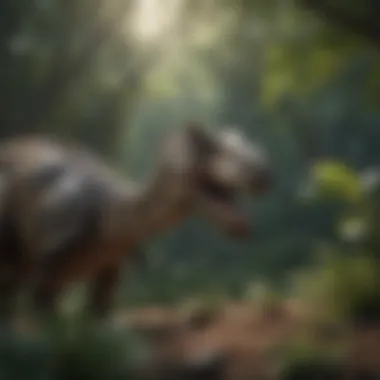Understanding Long Neck Dinosaurs: An In-Depth Examination


Intro
Long neck dinosaurs, often classified as sauropods, represent a fascinating dimension of paleontology. Their impressive anatomy and unique adaptations have intrigued both scholars and enthusiasts alike. This article will delve into various aspects of these remarkable creatures, aiming to shed light on their evolutionary journey, anatomical features, behaviors, and their ecological role.
Understanding long neck dinosaurs helps us appreciate the complexity of prehistoric life and contributes significantly to ongoing scientific discussions in paleobiology.
Research Overview
Summary of Key Findings
Recent research has unveiled several insights into the biology and lifestyle of long neck dinosaurs. Key findings include:
- Anatomy: Long neck dinosaurs exhibited an elongated neck that allowed them to reach high vegetation. Their large body size facilitated efficient food gathering across vast areas.
- Behavior: Fossil evidence suggests these dinosaurs likely lived in herds, providing social structure and protection against predators.
- Habitats: They thrived in diverse environments, from lush forests to open plains, influencing the structure of their ecosystems.
- Geographic Distribution: Fossils have been found on every continent, showcasing their adaptability and widespread presence during the Mesozoic era.
Relevance to Current Scientific Discussions
The study of long neck dinosaurs is pivotal in current scientific discussions, particularly concerning:
- Their role in ancient ecosystems: Understanding their interactions with flora and fauna helps reconstruct prehistoric environments.
- Evolutionary adaptations: Insights into their remarkable anatomical features help elucidate the evolutionary pressures that shaped their development.
- Climate change effects: The fossil record of these dinosaurs provides clues to how dinosaurs reacted to changes in climate and habitats.
"Studying these giants offers a window into the ecosystems of the distant past, revealing patterns of life that resonate with today’s environmental challenges."
Methodology
Research Design and Approach
To write this examination, various approaches were utilized. An analytical perspective was taken, combining fossil evidence with recent scientific literature to ensure a comprehensive overview of long neck dinosaurs.
Data Collection and Analysis Techniques
Data was collected through various means:
- Review of peer-reviewed journals and publications.
- Analysis of fossil finds and their geographic locations.
- Engagement with online scientific communities, including platforms like Reddit, to incorporate diverse viewpoints.
These methods contribute to a reliable understanding of long neck dinosaurs, offering insights into their past existence and ongoing significance.
Prelims to Long Neck Dinosaurs
Long neck dinosaurs, or sauropods, represent a significant and fascinating branch of the dinosaur family tree. Understanding these creatures is crucial for paleontologists, researchers, and anyone interested in the evolution of life on Earth. Their large size and unique anatomical features have captured the imagination of both scientists and the public alike.
This section serves as an entry point into the world of long neck dinosaurs. By examining their defining characteristics and historical context, readers can appreciate their role in prehistoric ecosystems and the evolutionary narrative of vertebrates. The study of these dinosaurs showcases not only their biology but also how they adapted to their environments, which offers insights into past climate changes and ecological shifts.
Gaining knowledge of long neck dinosaurs enhances our grasp of biodiversity. Such understanding can also inform conservation efforts for modern ecosystems, as studying these ancient animals underscores the importance of environmental stewardship.
Defining Characteristics
Long neck dinosaurs are renowned for their elongated necks, which could reach astonishing lengths. This anatomical feature is not merely for show; it allowed them to access vegetation that was otherwise unreachable by other herbivores. The neck of these dinosaurs is made up of numerous vertebrae, generally more than that of any other animal. This gave the sauropods a distinct advantage in their ecosystems.
Additional characteristics include:
- Large Body Size: They had massive bodies, which were supported by sturdy legs. The combination of large size and long necks made them formidable herbivores.
- Tail Structure: Many long neck dinosaurs possessed long tails, which balanced their body and neck. In some species, tails were used for defense against predators.
- Heavy Bones: Their skeletal structure was adapted to carry their weight, with specialized bones that provided strength without compromising agility.
- Dentition: The teeth of long neck dinosaurs were often adapted for grazing. They typically had flat, peg-like teeth that were efficient for stripping leaves and soft plant material.
Overall, the unique anatomical traits of long neck dinosaurs illustrate their evolutionary adaptations in a competitive world of large herbivores.
Historical Context
The history of long neck dinosaurs extends back to the Jurassic period, around 150 million years ago. These creatures thrived during a time when vast forests covered much of the planet. As herbivores, they played a crucial role in shaping these ecosystems. The discovery and classification of long neck dinosaurs have evolved significantly over the decades.
Scholars have worked diligently to piece together their history based on fossil evidence. Notable finds include:
- Brachiosaurus: Recognized for its relatively upright posture, Brachiosaurus showcases a different adaptation to feeding compared to other sauropods.
- Diplodocus: Known for its long neck and tail, this dinosaur illustrates the extremities that evolved in sauropods.
- Apatosaurus: Formerly known as Brontosaurus, recent studies have clarified its taxonomic position within sauropods.
Research into these long necked creatures continues to develop. Each fossil discovery provides new insights, reshaping our understanding of their behavior, ecology, and evolution. The historical significance of long neck dinosaurs cannot be understated, as they offer perspectives on life forms that long predate humankind.
"Long neck dinosaurs not only shaped their environment but also contributed significantly to the evolutionary tapestry of life. Understanding them will provide valuable perspectives in paleontological research."
Understanding the defining characteristics and historical context of long neck dinosaurs lays the groundwork for a deeper exploration of their evolutionary significance.
Evolutionary Significance
The evolutionary significance of long neck dinosaurs, a unique branch of sauropods, provides essential insights into the history of life on Earth. These dinosaurs exemplify the adaptability and diversity that can arise through evolution. By examining long neck dinosaurs, researchers can understand how this remarkable group responded to environmental pressures and evolving ecosystems. They present a case study on size, shape, and functional utility in evolutionary biology.
Arrival on the Scene
Long neck dinosaurs emerged during the Jurassic period, around 150 million years ago. Their arrival marked a turning point in the development of large herbivores. The earliest known form, Brachiosaurus, showcases the significant size increase and neck elongation seen in later species. Fossil evidence indicates that these dinosaurs occupied various niches within their ecosystems. Their size allowed them to reach vegetation that was unavailable to other herbivores, giving them a distinct advantage.
The evolutionary origins of long necks can be traced back to adaptations in feeding strategies. As vegetation evolved, many plants grew taller to access light. In response, longer necks became beneficial, facilitating access to foliage beyond the reach of other ground-dwelling animals. This shift exemplifies how species adapt commonly to changes in their environment, a principle represented across multiple taxa.
Adaptive Features
Long neck dinosaurs exhibit a range of adaptive features that contributed to their success. One of the most notable traits is their unique neck structure. The verteBRAE of these dinosaurs were elongated, allowing for flexibility and reach. This design enabled them to forage efficiently, providing access to high-canopy leaves and branches.
In addition to their necks, long neck dinosaurs possessed large bodies that served as leverage and support for their massive weight. This size not only provided protection from predators but also allowed them to store energy effectively.
Other adaptations included:
- Respiratory Systems: Their large lungs supported breathing during extensive movement and foraging.
- Social Behavior: Evidence suggests some long neck species traveled in herds, providing safety in numbers and enhancing foraging efficiency.
- Reproductive Strategies: Their reproductive cycles may have adapted to support the care and growth of offspring in perfect alignment with seasonal food availability.


"Studying the adaptations of long neck dinosaurs sheds light on evolutionary pressures that shape species over time."
These aspects underline the role of long neck dinosaurs in their ecosystems and present a comprehensive view of how they evolved. Such understanding informs not only paleoecological models but also contemporary discussions about adaptation in the face of environmental changes, proving pertinent in today's climate considerations.
Taxonomy of Long Neck Dinosaurs
The taxonomy of long neck dinosaurs is crucial for understanding their evolutionary relationships, diversity, and roles within prehistoric ecosystems. This section delves into how these magnificent creatures are classified into families and genera, shedding light on their specific traits and patterns. Taxonomy not only assists researchers in categorizing these dinosaurs but also provides insights into their biology, behavior, and adaptations over millions of years. Clarifying the taxonomic relationships offers a clearer context for studying their ecological significance.
Major Families and Genera
Long neck dinosaurs belong primarily to the clade Sauropoda, divided into several major families. These families vary greatly in size, shape, and ecological niches they occupied. Some of the prominent families include:
- Diplodocidae: Known for their extremely long necks and tails, members of this family include genera like Diplodocus. They were primarily herbivorous and fed on foliage high in trees.
- Apatosauridae: Initially known as Brontosaurus, this family consists of large, long-necked dinosaurs that thrived in various environments. They had robust bodies and were also herbivorous.
- Titanosauria: Representing one of the most diverse and widespread groups, titanosaurs show a variety of adaptations. Many of these were found in different continents, indicating they thrived in varied habitats.
- Brachiosauridae: Recognized for their long forelimbs, which made them stand taller than many other sauropods. An example includes Brachiosaurus, which could reach higher vegetation.
Understanding these families helps categorize different species based on their anatomical features and ecological roles. Each family presents unique adaptations to their environments, enhancing our understanding of their survival strategies.
Identifying Key Species
Identifying key species within these families is vital for paleontological studies. Notable species give insights into the evolutionary history and changes in morphology over time. Examples of significant species include:
- Mamenchisaurus: This species is famous for its extraordinarily long neck, reaching up to 15 meters. Found primarily in China, it illustrates adaptations to high browsing.
- Argentinosaurus: An iconic titanosaurs, believed to be one of the largest land animals ever, which offers clues about size advantages in specific environments.
- Sauroposeidon: Another giant, Sauroposeidon provides evidence of the height advantages in accessing foliage unavailable to other herbivores.
Identifying these species aids in uncovering more about their behavior, feeding habits, and adaptations to ancient ecosystems. Each specimen contributes pieces to the larger puzzle of sauropod evolution and ecology.
"The study of taxonomy in long neck dinosaurs offers crucial insight into their evolutionary paths and ecological roles, enabling better understanding of prehistoric life."
In summary, taxonomy serves as the foundation for exploring the diversity and complexity of long neck dinosaurs. Through the classification of families and identification of key species, researchers can connect anatomical traits with ecological function, enhancing our knowledge of these prehistoric giants.
Anatomical Features
Anatomical features of long neck dinosaurs are key to understanding their unique characteristics and adaptations. These features are not just interesting but also provide essential insights into their evolution, behavior, and ecological roles. The remarkable anatomy of these creatures allows them to thrive in various environments, influencing both their feeding mechanics and social interactions. Studying these attributes sheds light on how species adapted over millions of years to changing habitats and ecosystems.
Neck Structure and Function
The neck of long neck dinosaurs is an outstanding subject of study. Their necks, often comprising hundreds of vertebrae, are greatly elongated. This elongation is believed to have evolved primarily for feeding. By stretching their necks, dinosaurs such as Brachiosaurus could access food high in trees that other herbivores could not reach. It also aided them in grazing vast areas of plant life, an advantage in competition for resources.
Functionally, the neck also provided benefits in social settings. Studies suggest that neck movements could facilitate communication among individuals. For instance, during mating displays, certain species would raise their necks or engage in necking behavior. This social interaction might serve as a means to establish dominance or attract mates. The flexibility and strength of the neck are therefore crucial not only for feeding but also for social dynamics within groups.
Body Design and Size
The overall body design and size of long neck dinosaurs are equally significant. Most of these dinosaurs displayed a massive body, supported by strong legs and a relatively small head in proportion to their length. This design offered immense advantages in terms of weight distribution and stability. Their large size was often an essential factor in deterring predators, allowing them to relax while residing in regions where they could easily forage.
The size of long neck dinosaurs varied greatly among species. Some, like Argentinosaurus, were among the largest land animals in history, while others like Apatosaurus were smaller. This variation impacted their ecological roles significantly. Larger species could influence vegetation patterns more profoundly through their feeding habits by uprooting or consuming substantial flora, thereby reshaping the environments they inhabited.
Behavioral Patterns
Behavioral patterns of long neck dinosaurs offer insight into how these massive creatures interacted with their environment and each other. Understanding these behaviors is critical for comprehending their survival strategies and ecological roles. This section highlights the complexities behind their feeding strategies and social interactions, which contribute significantly to their adaptation in prehistoric ecosystems.
Feeding Strategies
Feeding strategies of long neck dinosaurs, commonly known as sauropods, highlight their ability to exploit available vegetation. Most long neck dinosaurs were herbivores, relying on a diet primarily made up of leaves, ferns, and other plant materials. Their long necks allowed them to reach high into the trees, accessing food sources that other dinosaurs could not.
Several factors influenced these feeding strategies:
- Heightened Reach: Long necks provided the ability to browse at various heights. This adaptation minimized competition for food between different species, as they could consume foliage from different strata of the forest.
- Selective Foraging: Some species, like Brachiosaurus, possibly had preferences for certain types of vegetation. This selective foraging may have helped maintain their energy levels, allowing for better survival in changing environments.
- Grazing Approaches: Knowledge about the durability of their teeth suggests they might have been equipped for processing tough plant material. By effectively grazing and browsing, they were able to maintain a balanced diet to support their size.
Social Interaction
Social interactions among long neck dinosaurs are a testament to their complex behaviors. Evidence suggests that these creatures may have displayed various social behaviors that offered advantages for their survival.
- Herd Dynamics: Some studies imply that long neck dinosaurs might have traveled in herds. This social structure could provide safety in numbers, reducing individual predation risk. Herds might also facilitate communication and coordination among individuals.
- Parental Care: Parental investment is another critical aspect of social behavior. Fossil evidence shows that some species may have engaged in protective behaviors to ensure the survival of their young.
- Communication: Long neck dinosaurs likely had ways to communicate with each other, possibly through vocalizations or body movements. Such communication could be essential during mating season or when protecting territory.
Understanding the feeding strategies and social interactions of long neck dinosaurs sheds light on how these majestic creatures thrived and adapted in their environments, influencing their roles within ecosystems.
These behavioral patterns not only underline the adaptability of long neck dinosaurs but also reflect their overall significance in the prehistoric world. This comprehension enhances our knowledge of their ecological dynamics and allows paleontologists to draw conclusions about the conditions of Earth's past.
Habitat and Geographic Distribution
Understanding the habitat and geographic distribution of long neck dinosaurs provides insights into their adaptability and the ecosystems they inhabited. These dinosaurs thrived in a variety of environments, from lush floodplains to arid regions, showcasing their resilience and ecological versatility. This section details the specific elements that affected these prehistoric creatures and highlights the significance of their habitats in shaping their evolution and behavior.
Understanding Their Environment
Long neck dinosaurs, part of the sauropod group, occupied diverse environments. Their habitats were essential for feeding, breeding, and social interaction. These areas included:
- Coastal Floodplains: Rich in vegetation and freshwater sources, these locations supported lush plant life, which was crucial for their herbivorous diet.
- Forested Regions: Dense forests offered a variety of plant species. These habitats also provided shelter from predators and harsh weather conditions.
- Dry Areas: Some species adapted to arid climates, relying on their long necks to reach high branches or forage for sparse vegetation.
The availability of food resources directly influenced the distribution of these dinosaurs. Fossil evidence indicates that long neck dinosaurs migrated in response to changing climates, particularly during droughts. This flexibility in habitat choice contributed to their success and longevity.
Fossil Findings Across Continents
Fossil findings of long neck dinosaurs have emerged from various continents, illustrating their widespread existence across the globe. Key discoveries have been made in regions such as:
- North America: The Denver Basin is known for yielding numerous sauropod fossils, helping to piece together their living conditions.
- South America: Argentinosaurus, one of the largest known dinosaurs, was discovered here. Its size reflects the abundant food supply available in this environment.
- Asia: Fossils from Mongolia contribute to understanding how these dinosaurs adapted to different climatic conditions.
- Africa: Sites in Tanzania and South Africa have revealed species that thrived in unique habitats specific to the continent.
Across these continents, the evidence showcases how long neck dinosaurs adapted to suit their environments. Their fossils highlight variations that reflect dietary preferences and ecological niches.
The geographic distribution of these dinosaurs also plays a role in understanding migration patterns. The climatic changes during the Mesozoic Era influenced these movements, revealing how they responded to environmental challenges. The factors surrounding their habitat and geographic distribution are critical for comprehending not only the life of long neck dinosaurs but also the paleoecological dynamics of their time.
Paleoecological Implications


The study of paleoecological implications provides critical insights into the role long neck dinosaurs played within ancient ecosystems. By examining their interactions with the environment and other species, researchers can better understand not only the life these creatures led but also the ecosystems they inhabited. The dynamics of these prehistoric habitats shaped through the presence and behaviors of long neck dinosaurs provide a unique lens through which we can observe evolutionary processes.
Long neck dinosaurs, primarily sauropods, were significant herbivores that likely influenced the vegetation patterns of their habitats. They fed on a variety of plant life, from low-lying shrubs to treetops, demonstrating a level of adaptability that positioned them as ecosystem engineers. Their feeding habits had multiple benefits: they could help in seed dispersal, thus promoting plant diversity, and their movements across landscapes may have facilitated nutrient cycling in the soil.
"Paleoecology examines how ancient life forms, including long neck dinosaurs, shaped their environments and how those environments shaped them in turn."
Ecosystem Dynamics
Long neck dinosaurs played an integral role in the dynamics of the ecosystems they thrived in. Their sheer size not only defined their physical presence but also influenced the structure and sustainability of the habitat. As primary consumers, they impacted the trophic levels significantly. Their grazing habits could lead to changes in the composition of flora, thus redefining the ecosystem's dynamics over time.
Notably, different species of long neck dinosaurs exhibited varying behaviors that contributed to ecological diversity. For instance:
- Some species were high feeders, reaching up to consume leaves from tall trees, while others targeted ground-level foliage.
- This feeding strategy minimized competition for resources among herbivores, allowing multiple species to coexist in the same environment.
- Variances in their feeding mechanisms also led to different nutrient cycling processes, supporting a broader range of habitation.
Impact on Vegetation Patterns
The impact of long neck dinosaurs on vegetation patterns is particularly significant. Their ability to consume large quantities of plant matter had profound effects on both flora diversity and vegetation growth. With their long necks, these dinosaurs could access plant materials that were often not reachable by smaller herbivores.
As they fed, long neck dinosaurs:
- Stimulated growth: By selectively grazing on dominant plant species, they allowed less competitive species to flourish.
- Facilitated succession paths: Their feeding behavior likely encouraged ecological succession, changing vegetation from one dominant type to another over time.
- Altered habitats: Large herds of these dinosaurs could trample the ground, affecting soil structure and promoting certain plant types.
Through these processes, long neck dinosaurs contributed to the development of diverse ecosystems that could support a myriad of species. Understanding these implications offers valuable insights into the ecological history of our planet and emphasizes the interconnectedness of life forms throughout geological time.
Fossilization and Preservation
Fossilization and preservation are critical in the study of long neck dinosaurs, known as sauropods. Their fossils provide unparalleled insight into their morphology, behavior, and environments. Understanding how these fossils form, and the conditions necessary for their preservation, is vital for reconstructing their life ways and earthy interactioms.
Fossils form primarily through sedimentation. Soft tissues decay quickly after an animal dies, but hard parts like bones can survive. For long neck dinosaurs, the conditions of burial greatly affect how well fossils are preserved. Areas like river deltas or floodplains, where sediment accumulates rapidly, tend to yield more complete and well-preserved specimens.
Benefits of Fossilization and Preservation
- Evidential Basis: Fossils serve as concrete evidence of the existence of long neck dinosaurs. They help paleontologists connect dots about when and where these creatures lived.
- Evolutionary Studies: Through fossil record, researchers can trace evolutionary changes and adaptations over millions of years, showing how long neck dinosaurs adapted to their environments.
- Behavioral Insights: Fossilized remains can suggest feeding habits, social structure, and other behavioral aspects through associated finds, like fossilized dung or tracks.
Considerations regarding fossilization and preservation are paramount. Environmental factors such as temperature, moisture, and chemical conditions play roles in the durability of fossils. Moreover, human activity and climate change pose significant threats to existing fossil sites, hindering future research. Protecting these sites is crucial for ongoing paleontological studies.
“The preservation of fossils allows us to glimpse into a world that existed millions of years ago, providing context to the evolution of life on Earth.”
Key Fossil Sites
Various key fossil sites around the globe have yielded significant discoveries relating to long neck dinosaurs. Notably, the Morrison Formation in the United States is famed for its abundance of sauropod fossils. It has provided important insights into their variety and evolutionary history. Sites in Argentina, particularly in the Patagonia region, also hold many important finds, including the Gigantosaurus and the enormous Argentinosaurus. These sites exemplify how specific geological periods contributed to our understanding of these creatures.
Techniques in Paleontology
The study of long neck dinosaurs relies heavily on advanced paleontological techniques. Below are some key methods used in the field:
- Stratigraphy: Analyzing rock layers helps determine the age of the fossils and their environmental context.
- Radiological Imaging: Techniques like CT scans enable scientists to visualize internal structures of fossils without damaging them, revealing details about their anatomical features.
- Isotopic Analysis: This method provides information about the diet and habitat preferences of long neck dinosaurs by examining the chemical composition of their teeth and bones.
In summary, fossilization and preservation lie at the core of palaeontological studies for long neck dinosaurs. They give us the tools to scientifically investigate these remarkable creatures, enhance our knowledge of their past, and inform conservation efforts for the future.
Recent Discoveries
Recent discoveries in the field of paleontology have shed light on the fascinating world of long neck dinosaurs. These findings are crucial, as they not only enhance our understanding of these giant creatures but also refine our views on their ecology and behavior. Every new fossil unearthed has the potential to reshape previous assumptions. Thus, it is important to explore these advancements and their implications thoroughly.
Advancements in Research
The last few years have seen significant advancements in research methodologies surrounding long neck dinosaurs. Modern techniques such as CT scanning and 3D modeling have allowed scientists to analyze fossilized remains with unprecedented detail. These technologies enable researchers to recreate the anatomical structures of these dinosaurs, providing insights into their growth patterns and physical capabilities.
Many studies focus on a nuanced understanding of long neck anatomy. For instance, researchers have looked into the mechanics of neck movement. This is significant because it can affect theories on feeding strategies and social behavior.
"Recent technological innovations facilitate a deeper analysis of ancient life, improving interpretations of the fossil record."
Another advancement is the integration of paleogenomics. By examining the genetic material of closely related species, scientists can infer the evolutionary history of long neck dinosaurs. Such investigations allow paleontologists to paint a richer picture of their lifestyle and environment through time, ensuring that our understanding is reflective of dynamic changes in ecosystems.
New Species Identified
New discoveries have also led to the identification of additional species within the long neck dinosaur clade. Data from recent fossil excavations in places like Argentina and China have brought to light species that were previously unknown to science. Each of these new species offers a glimpse into the diversity of forms and functions that these dinosaurs exhibited.
For example, the discovery of Nanyangosaurus in China has raised questions about the adaptability of long neck dinosaurs in diverse environments. Unlike its relatives, Nanyangosaurus showcases a unique set of physical traits, suggesting it thrived in a different ecological niche compared to other known sauropods. This expands our understanding of how these creatures interacted with their environment and contributes to discussions about their evolutionary adaptations.
Overall, these new species play a vital role in reconstructing the phylogenetic tree of long neck dinosaurs, thereby illuminating the paths of evolution they traveled. Researchers emphasize the need for continued excavation and analysis to uncover more of these hidden gems in paleontological records, as each discovery provides crucial context for understanding the environmental changes during their time on Earth.
The Role of Long Neck Dinosaurs in Popular Culture
Long neck dinosaurs, primarily the sauropods, have captured the imagination of people across generations. Their unique anatomy and enormous size set them apart and made them symbols of prehistoric life. In popular culture, these creatures serve as both educational tools and sources of entertainment. Their representation influences not only how the public views dinosaurs but also shapes the understanding of paleontology as a whole.
Representation in Media
Long neck dinosaurs have appeared in various forms of media, including movies, documentaries, children's books, and toys. One of the most iconic films featuring these giants is "Jurassic Park.” In this movie, the Brachiosaurus stands majestically, showcasing its long neck in a stunning visual. Such portrayals create a vivid image of what these dinosaurs might have been like, stimulating interest in their biology and behavior.
Other media, including animated shows and educational content, often depict long neck dinosaurs in ways that highlight their feeding habits and lifestyle. Documentaries like "Walking with Dinosaurs" elaborate on their ecological role, emphasizing their, place within the prehistoric environment. This educational angle informs viewers about anatomy, evolution, and the significance of these creatures as herbivores.
The use of long neck dinosaurs in merchandise, such as toys and collectibles, cements their status in popular culture. Children’s toys often feature bright colors and exaggerated features, making them appealing to young audiences. This early exposure can foster a lifelong interest in paleontology and science, underlining the importance of these dinosaurs in educational contexts.
Cultural Significance
The cultural impact of long neck dinosaurs extends beyond entertainment. They have become symbols of wonder and curiosity about the natural world. These creatures represent the vast ages of Earth and evoke a sense of exploration. Their size often indicates a majestic, peaceful existence, a stark contrast to the common portrayals of carnivorous dinosaurs which are often depicted as fierce and dangerous.
Culturally, these dinosaurs also serve as a tool for teaching important concepts in science. By exploring their characteristics and roles in prehistoric ecosystems, long neck dinosaurs help society understand biodiversity, evolution, and conservation.


Additionally, they can symbolize various broader themes within human culture, such as the triumph of life's adaptability and the need for preservation of the Earth’s history. The fascination with long neck dinosaurs also leads to discussions on extinction and environmental issues, making them pertinent figures in current ecological dialogues.
Ultimately, long neck dinosaurs represent not just a part of our planet’s prehistoric past, but also serve as reflections of our cultural narratives and educational pursuits.
In summary, the role of long neck dinosaurs in popular culture is multifaceted. Their representations in media provide entertainment while fostering educational opportunities. The cultural significance of these creatures highlights their ability to inspire curiosity and promote scientific understanding. This dual role ensures that long neck dinosaurs remain relevant in both academic discussions and popular discourse.
Challenges in Research
The study of long neck dinosaurs presents unique challenges that are critical to understanding these creatures and their ecological roles. These challenges are not just technical but can also impact the overall narrative of long neck dinosaurs within the context of paleontology. Comprehensive knowledge about geological constraints and preservation issues can significantly improve future inquiries into this area.
Geological Constraints
Geological constraints refer to the limitations presented by the physical and chemical characteristics of the rock layers where fossils are found. The composition of sedimentary rocks, such as the degree of compaction and mineralization, directly affects fossil preservation. Research in this area faces hurdles, particularly in fossil-rich locations that have experienced significant geological upheaval.
When earth movements occur, such as tectonic shifts, fossils can be buried too deep or scattered, making them harder to locate. Therefore, many sites may reveal only fragments of long neck dinosaurs, which leads to gaps in understanding their biology and behavior. Consequently, paleontologists must engage in extensive fieldwork, leading to high costs and requiring a great deal of time to analyze these geological formations.
"Geological constraints can obscure our view of ancient ecosystems, making it crucial to approach fossil excavation with a keen understanding of the underlying geology."
Preservation Issues
Fossil preservation is another significant challenge in researching long neck dinosaurs. The chemical and environmental factors that affect fossilization can vary widely depending on the site. For example, some bones may not survive the fossilization process due to erosion, acidic conditions, or human interference.
Efficient preservation techniques must be developed to protect these valuable specimens. Techniques such as resin coating or advanced digital scanning can help in managing the degradation of fossil material. However, these methods require substantial investment and expertise.
Additionally, there is the continually looming issue of looting in fossil-rich areas, where individuals may illegally remove specimens for personal gain. This not only disrupts the scientific record but also reduces the availability of materials for ongoing research. The preservation of paleontological sites is vital for ensuring that future generations can study the biological history of long neck dinosaurs.
Through addressing these geological constraints and preservation issues, researchers can enhance their understanding of these remarkable creatures and contribute substantially to the field of paleontology.
Conservation of Paleontological Sites
Conservation of paleontological sites plays a vital role in the continued understanding of long neck dinosaurs. These sites not only preserve the physical remains of these ancient creatures but also provide insights into their ecosystems, behaviors, and environments. The loss of these sites can result in irreversible damage to our scientific knowledge and future discoveries.
Paleontological sites are often under threat from natural processes and human activities. Erosion, climate change, and urban development can cause degradation of these important locations. Protecting them ensures that fossils and the contextual data associated with them remain intact. This safeguarding is crucial for ongoing research and education, as new species and insights often emerge from previously excavated regions.
"Every fossil recovered contributes to the understanding of evolution, behavior, and ecology of species like the long neck dinosaurs. Protecting these sites is essential for future discoveries."
Importance of Safeguarding
Safeguarding paleontological sites is important for several reasons:
- Scientific Research: Protecting fossils allows for ongoing and future research. These sites can yield new species or information about existing ones.
- Cross-Disciplinary Studies: They provide a basis for studies in geology, biology, and climate science. The data derived can inform multiple fields of study.
- Cultural Heritage: Fossils are part of human history and natural heritage. They connect us to the planet’s past and the evolution of life.
Conservation efforts contribute to maintaining the integrity of scientifically significant sites. This in turn promotes education and awareness about paleontology, its methods, and its importance.
Efforts in Conservation
Efforts to conserve paleontological sites include both governmental and non-governmental initiatives. Many countries have established laws to protect significant fossil sites from excavation and development. For example, in the United States, the Antiquities Act allows for the protection of fossils on public lands.
Non-profit organizations and universities often contribute through scientific research and educational programs. They engage in fieldwork to study sites and create awareness about their ecological significance. Some common conservation strategies include:
- Site Monitoring: Regular assessments help understand the impacts of environmental changes on fossil sites.
- Public Engagement: Workshops and educational programs for communities raise awareness on the significance of these archaeological treasures.
- Collaboration with Local Governments: Partnerships can establish regulations and guidelines to protect these sites effectively.
In summary, conservation of paleontological sites is essential for preserving our connection to long neck dinosaurs and other prehistoric life forms. By prioritizing the protection of these sites, we can ensure that future generations have the opportunity to learn from and build upon the discoveries of the past.
Future Research Directions
Importance of Future Research Directions
The study of long neck dinosaurs has immensely contributed to our understanding of prehistoric life. However, the field of paleontology is continually evolving, highlighting the need for ongoing research in this area. Future research is significant as it aims to uncover new data that can reshape our current understanding of these ancient creatures. As new fossil sites are discovered and technologies advance, researchers have the opportunity to analyze insights previously out of reach.
Exploring future directions involves a range of scientific questions still unanswered regarding the physiology, behavior, and ecological roles of long neck dinosaurs. This endeavor not only deepens our understanding of specific species but also impacts our broader comprehension of dinosaur evolution and extinction events. It is essential for students, researchers, and educators to remain engaged in this dialogue and contribute actively to pioneering work.
Innovative Methodologies
In order to advance research in this area, innovative methodologies have become increasingly vital. These techniques offer fresh perspectives on fossil interpretation and the reconstruction of paleoecological conditions. For instance, the application of advanced imaging technologies like computed tomography (CT) scans enables paleontologists to examine internal structures without damaging fossils. Additionally, techniques such as isotopic analysis provide insights into dietary habits and environmental interactions of long neck dinosaurs.
Furthermore, molecular biology approaches, including the study of ancient DNA, may reveal genetic information that enhances our knowledge of these dinosaurs.
Interdisciplinary Approaches
The study of long neck dinosaurs benefits significantly from interdisciplinary approaches. For example, collaboration between paleontology and geology can improve our understanding of the sedimentary processes that contributed to fossil formation. Similarly, an integration of evolutionary biology can aid in constructing phylogenetic trees that highlight evolutionary relationships among species. By embracing a multidisciplinary perspective, researchers can develop a more holistic view of how these dinosaurs lived and interacted with their environment.
Moreover, engaging with technology and computer modeling can simulate ecological conditions based on fossil evidence. This dynamic approach can lead to fruitful discussions about the implications of environmental changes over time, providing a deeper context to long neck dinosaurs' adaptations and extinction.
Ultimately, future research directions hold great promise for elucidating the complexities surrounding long neck dinosaurs. Each proposed method and interdisciplinary collaboration stands to enhance the existing body of knowledge, offering valuable contributions to the fields of paleontology and evolution.
Closure
The conclusion section is vital for synthesizing the insights gained throughout the examination of long neck dinosaurs. It distills the key findings and reinforces the significance of these remarkable creatures in paleoecological studies. This section provides closure to the discussion while also opening pathways for future inquiries.
Summary of Findings
The study of long neck dinosaurs reveals several crucial insights:
- Evolutionary Adaptations: These dinosaurs exhibit unique adaptations, specifically their neck structure, which allowed for efficient feeding strategies and the ability to exploit various vegetation types.
- Behavioral Insights: Behavioral patterns observed in fossils suggest complex social interactions and group dynamics. Understanding these behaviors sheds light on their ecological roles.
- Paleoecological Impact: Long neck dinosaurs significantly influenced prehistoric ecosystems, impacting vegetation patterns and competing with other species for resources.
Through fossil evidence and various research findings, the trajectory of their existence becomes clear. Their rise and eventual decline play a key role in understanding the broader picture of prehistoric life.
Significance in Paleontology
The significance of long neck dinosaurs in paleontology cannot be overstated. They serve as critical indicators of evolutionary trends and ecosystem structures of the Mesozoic era. As researchers uncover new fossils and develop better methodologies, long neck dinosaurs continue to contribute to our understanding of evolutionary biology and ecology.
- Ecosystem Dynamics: Their role in shaping and influencing ancient environments illustrates the interconnectedness of species and their habitats.
- Research Implications: Ongoing discoveries enhance our comprehension of adaptive strategies in response to environmental shifts, raising questions about resilience and extinction.
- Cultural Relevance: Beyond science, these dinosaurs captivate public imagination and inspire continued interest in paleontological research, which aids educational efforts and engagement with science.
In sum, long neck dinosaurs are not merely figures of curiosity; they are essential to the fabric of paleontological research, representing a confluence of evolutionary history and ecological dynamics.



